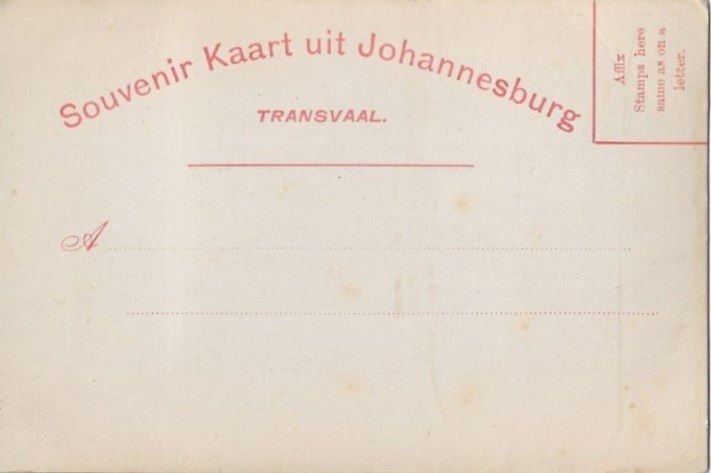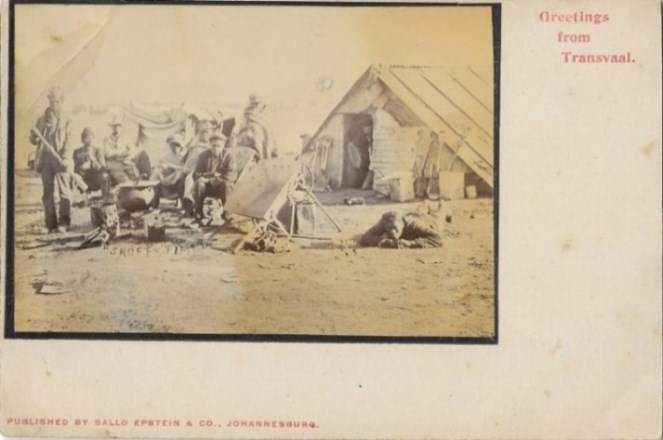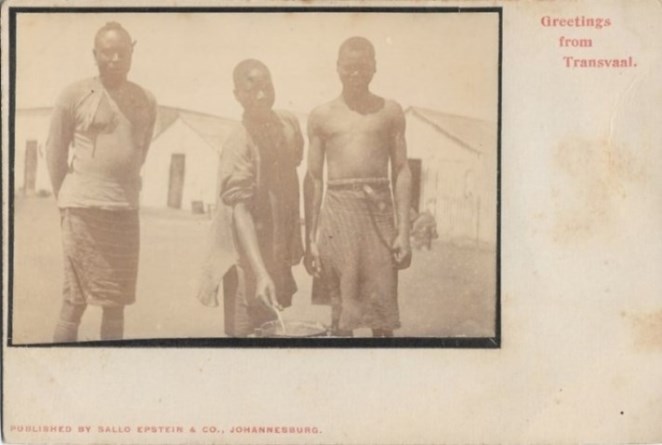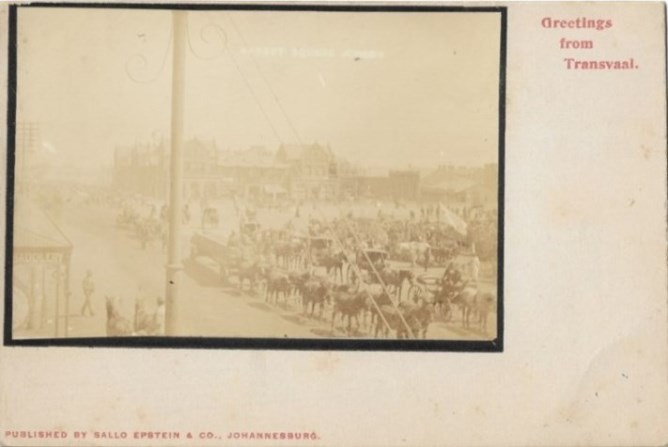Sallo Epstein is remembered today as one of the first publishers of illustrated postal stationery cards and picture postcards in the South African Republic (Transvaal). The picture postcards here have been recorded by Bram Leeflang in his 2019 book, Pioneer Postcards of South Africa 1896-1900 Stationery and non-stationery picture postcards of the Boer Republics, Cape of Good Hope and Natal. Bram notes that they were published in 1899, and assigned this series of picture postcards as Sallo Epstein ‘Group 12’. He illustrated six different cards and gave them the following numbers, 12.1, 12.2, 12.3, 12.4, 12.5, and 12.6. Illustrated below are a further three cards which are recent finds, and are recorded as 12.7, 12.8, and 12.9.

The address side of these cards are printed in red, ‘Souvenir Kaart uit Johannesburg’ / 'TRANSVAAL.’ The boxed area for the adhesive postage stamp informs the sender that the postage rate for postcards was the same as that of ordinary letter mail. ‘Affix Stamps here as on a letter.’ The postage rates for local mail as published during 1898 are given below - see Notes and References.
The design of the address side has been influenced by the contemporary South African Republic postal stationery cards. It is possible that the printing of these Sallo Epstein cards was in Europe; Germany or the Netherlands, before being forwarded to Johannesburg, where the photographs were adhered to the cards.
The picture side is also printed in red, at top right, ‘Greetings from Transvaal.’ and at bottom left. ‘PUBLISHED BY SALLO EPSTEIN & Co., JOHANNESBURG’ In true Victorian / Edwardian compositor style, six different founts (typeface or fonts) have been used.
These postcards have a much thicker board than most other picture postcards. This was possibly to prevent the board from curling following the photograph being adhered to the board with paste. None of these postcards have captions to the photographs. These photographs must have been too large for the black printed boarder, therefore all three here have been trimmed at the foot. However, those who undertook this task did not use a knife and straight edge, which unfortunately, gives the production of these postcards an amateur appearance.

12.7 African (Black) miners dressed in European hand-me-down clothes and three wrapped in blankets. They are posing for the photograph, and appear to be taking a rest around a fire while cooking their food. One miner lays face down on the ground and another can be seen peering from the corrugated roofed, tent like structure. Note the upturned wheelbarrows used as seating for four of the miners. Just below the brazier and written in uppercase is 'SKOFF TIME'.
 12.8 Three African mineworkers photographed in a Witwatersrand gold or coal mine compound. On some of these compounds a cooking area for the miners were placed in the middle of the compound, most probably as a fire precaution.
12.8 Three African mineworkers photographed in a Witwatersrand gold or coal mine compound. On some of these compounds a cooking area for the miners were placed in the middle of the compound, most probably as a fire precaution.
 12.9 Dusty Market Square, Johannesburg. The photograph was taken before January 1899 and shows a loaded ten mule wagon. Alongside are the four wheeled horse cabs waiting for hire. There was always plenty of cabs available. To the left is a saddlery and opposite are Market Buildings (Covered Market).
12.9 Dusty Market Square, Johannesburg. The photograph was taken before January 1899 and shows a loaded ten mule wagon. Alongside are the four wheeled horse cabs waiting for hire. There was always plenty of cabs available. To the left is a saddlery and opposite are Market Buildings (Covered Market).
Notes and ReferencesLeeflang, B. (2019) Pioneer Postcards of South Africa 1896-1900 Stationery
and non-stationery picture postcards of the Boer Republics, Cape of Good Hope and Natal, pp.111-112
[A review of this book can be found on this website on the 'Postcard page' + 'Postcard Book Reviews'.South African Republic Postal Law No.18, 1898, LAW No.18, (1898).[The postage rates in 1898 were as followed:]SCHEDULE “A.”Letters. – Postal for delivery within the same place, or for delivery by another Post Office within the State, for every half-ounce or portion thereof. One penny.
Newspapers. – For each newspaper, if not more than four ounces in weight. One half-penny.
Post-Cards. – For each post-card. One half-penny.
Books and Sample Packets. One half-penny.
Packets. – For each packet not exceeding eight ounces in weight. Four pence.
For every additional four ounces or portion there of. Two pence.
Registration. – For the registration of each separate article. Four pence.
S. J. P. Kruger, State President
F. W. Reitz, State Secretary
Government Office, Pretoria, November 11th, 1898
[The overseas postcard rate was two and half-penny. This rate was to remain into the British occupation.]
-- 'Back' --
-- 'Home Page' --
Copyright © Jeff Woolgar 2023- - o- -